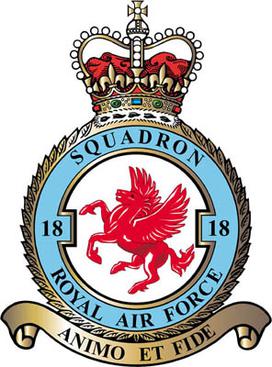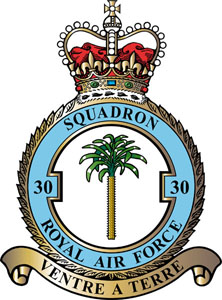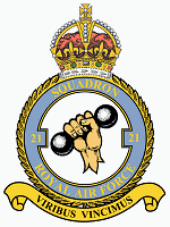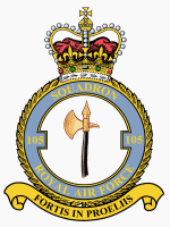
Number 8 Squadron of the Royal Air Force last operated the Boeing E-3D Sentry AEW1 (AWACS) from RAF Waddington, Lincolnshire. As of 2020, the RAF AWACS fleet was made up of three Sentry AEW1s, down from seven originally ordered in the late 1980s. Pursuant to the 2021 defence review, the E-3D Sentry aircraft made its final flight in U.K. service in August 2021.

Number 6 Squadron of the Royal Air Force operates the Eurofighter Typhoon FGR.4 at RAF Lossiemouth. It was previously equipped with the SEPECAT Jaguar GR.3 in the close air support and tactical reconnaissance roles, and was posted to RAF Coltishall, Norfolk until April 2006, moving to RAF Coningsby until disbanding for the first time in its history on 31 May 2007. The squadron officially reformed as a Typhoon squadron on 6 September 2010. No. 6 Squadron is unique in having two Royal standards, having been awarded its second one by King Abdullah I of Jordan in October 1950 due to its long period of service in the Middle East.

Number 4 Squadron, normally written as No. IV Squadron, is a squadron of the Royal Air Force. Since November 2011, it has operated the BAE Hawk T2 from RAF Valley, Anglesey, Wales. The squadron provides weapons and tactics training for student pilots after they have completed their conversion to jet aircraft with No. XXV(F) Squadron. Between 1970 and January 2011, No. IV Squadron operated various marks of the Hawker Siddeley Harrier and British Aerospace Harrier II.

No. 18 Squadron of the Royal Air Force operates the Boeing Chinook from RAF Odiham. Owing to its heritage as a bomber squadron, it is also known as No. 18 (B) Squadron.

No. 27 Squadron of the Royal Air Force operates the Boeing Chinook from RAF Odiham.

No. 14 Squadron of the Royal Air Force currently operates the Beechcraft Shadow R1 in the Intelligence, surveillance, target acquisition, and reconnaissance (ISTAR) role from RAF Waddington.

Number 30 Squadron of the Royal Air Force operates the Airbus A400M Atlas transport aircraft and is based at RAF Brize Norton, Oxfordshire.

Number 47 Squadron is an inactive squadron of the Royal Air Force. Previously based at RAF Brize Norton, Oxfordshire, it last operated the Lockheed Martin Hercules C4/C5 between 2013 and 2023. It previously flew the Lockheed Hercules C.1/C.3 between 1968 and 2013.

No. 84 Squadron of the Royal Air Force is at present a Search and Rescue Squadron based at RAF Akrotiri, using the Westland/Airbus Helicopters Puma HC Mk.2 helicopter. The squadron transitioned from the previously operated Bell Griffin HAR.2 to the Puma HC.2 in 2023.

No. 21 Squadron of the Royal Air Force was formed in 1915 and was disbanded for the last time in 1979.

No. 26 Squadron of the Royal Air Force was formed in 1915 and was disbanded for the last time in 1976.

No. 35 Squadron was a squadron of the Royal Air Force.

No. 40 Squadron of the Royal Air Force was formed in 1916 at Gosport as No. 40 Squadron Royal Flying Corps and was disbanded for the last time in 1957. The squadron also included many non-British members, including volunteers from the Royal Australian Air Force and Royal Canadian Air Force.

Army Aviation Centre (AAC) Middle Wallop is a British Army airfield located near the Hampshire village of Middle Wallop, used for Army Air Corps training. The base hosts 2 (Training) Regiment AAC and 7 (Training) Regiment AAC under the umbrella of the Army Aviation Centre. 2 (Training) Regiment performs ground training; 7 (Training) Regiment trains aircrew on AAC aircraft after they complete basic training at RAF Shawbury.
No. 53 Squadron was a Royal Air Force squadron that saw service in both the First and Second World Wars.
No. 113 Squadron began service in 1917 with the Egyptian Expeditionary Force commanded by General Edmund Allenby. Initially, the squadron was a unit of the Royal Flying Corps, serving during the Sinai and Palestine Campaign and as a reconnaissance, army cooperation, bomber, fighter, transport and missile operation squadron during its existence.
No. 62 Squadron of the Royal Air Force was originally established as a Royal Flying Corps squadron in 1916 and operated the Bristol F2B fighter in France during the last year of the First World War. After the war the squadron was disbanded and it was re-established in 1937 as part of the buildup of the RAF in the late 1930s. During the Second World War the Squadron was deployed to the Far East, operating the Bristol Blenheim from Singapore and Malaya. In 1942 No. 62 Squadron was re-equipped with the Lockheed Hudson and it moved to Sumatra, then Burma and then India. After the close of World War II the squadron disbanded for the second time. It was briefly re-established from 1946 to 1947 as a Dakota squadron and operated out of Burma and India. It final incarnation was as a Bristol Bloodhound missile unit in the early 1960s.

No. 105 Squadron was a flying squadron of the Royal Air Force, active for three periods between 1917 and 1969. It was originally established during the First World War as a squadron of the Royal Flying Corps and disbanded after the war. Reactivated shortly before the Second World War, it was inactive again after the conflict. During its second existence it was a bomber unit and had the distinction to be the first to operate the de Havilland Mosquito light bomber. During the 1960s it was reactivated again for six years to provide transport support for the British Army in the Aden Protectorate and the Far East.
Number 88 Squadron was an aircraft squadron of the Royal Air Force. It was formed at Gosport, Hampshire in July 1917 as a Royal Flying Corps (RFC) squadron.
No. 114 Squadron was a squadron of the British Royal Air Force. It was first formed in India during the First World War, serving as a light bomber squadron during the Second World War and as a transport squadron post-war. It was last disbanded in 1971.














